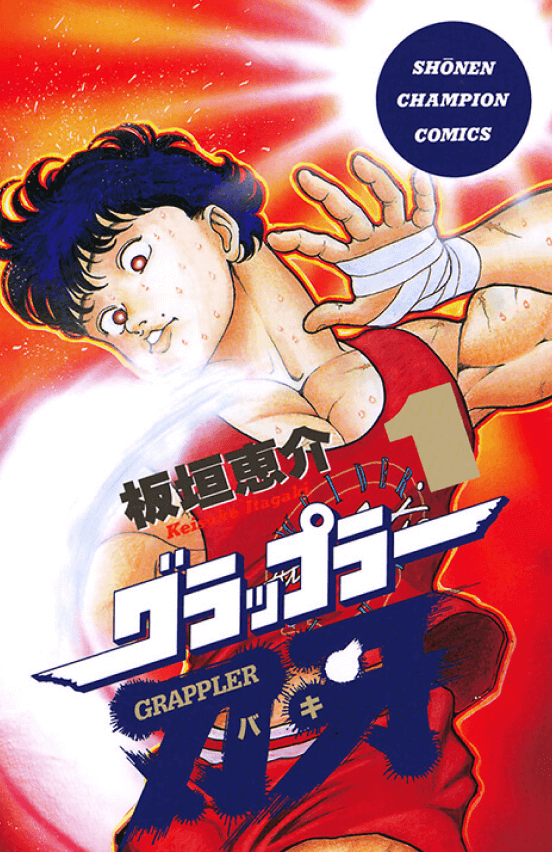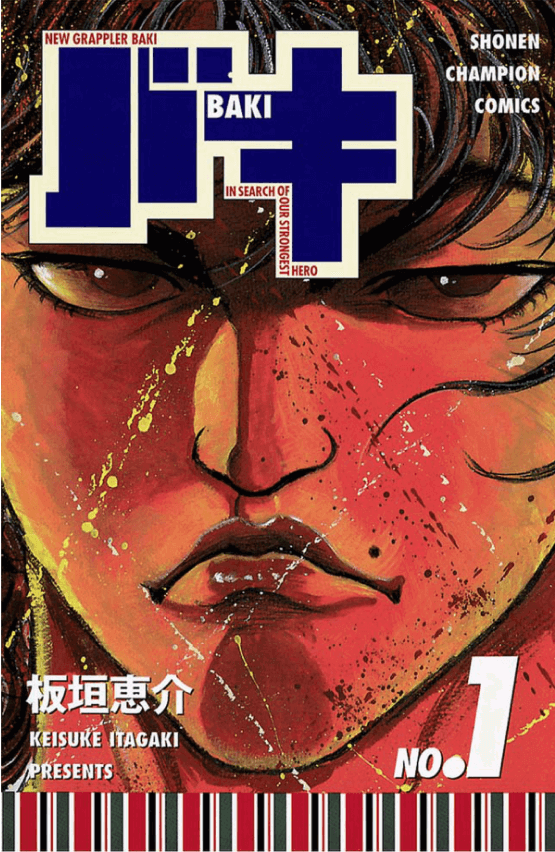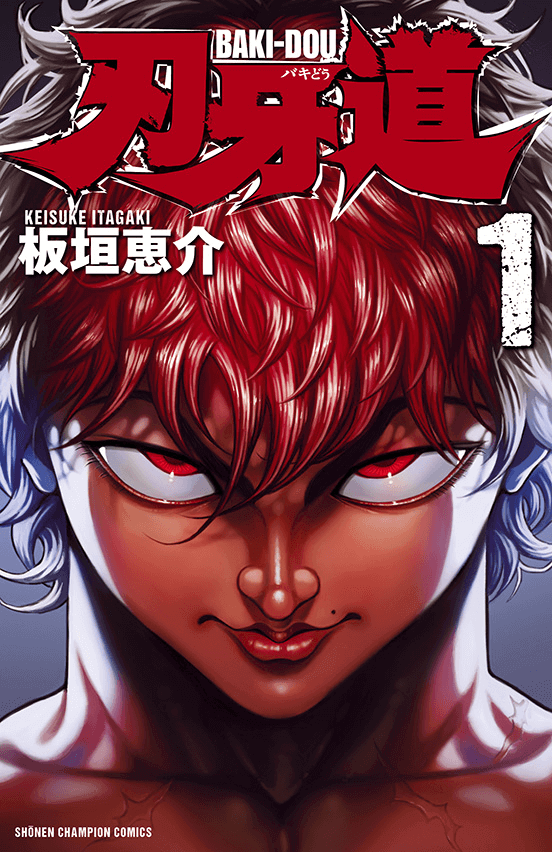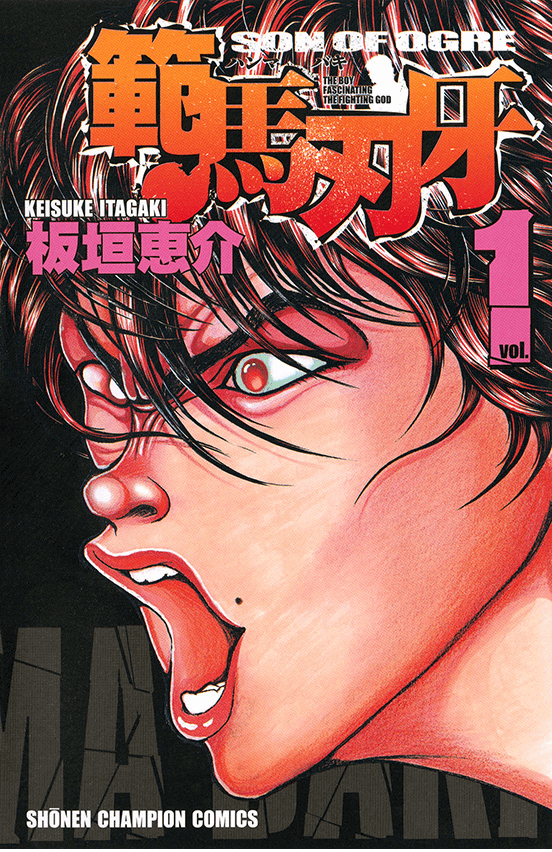If JoJo’s Bizarre Adventure is the gold standard for surreal manga odysseys, Keisuke Itagaki’s Baki the Grappler is its bare-knuckled cousin in the martial arts genre. While other formative martial arts manga and their anime adaptations maintain a sense of hyper realism with the fidelity of their fisticuffs, Baki’s manga arcs and Netflix anime adaptations planted its flag as one for the sickos who aren’t here to save the day and just want to fight—no matter how outlandish the reality-breaking terms are.




Shonen Champion Comics
Baki follows Baki Hanma, a street fighter so obsessed with combat that he treats sanctioned tournaments and back-alley brawls with equal reverence. His goal is to become the strongest being alive—a title currently held by his father, Yujiro Hanma. Throughout Baki’s pursuit of greatness and his stepping out of his father’s looming shadow, his hero's journey takes him through a gauntlet of increasingly deranged opponents including roided-out brawlers and prehistoric cavemen. All of this is vividly brought to life by Itagaki, who emphasizes and exaggerates human anatomy and the many ways muscles can bend and break. Baki is one of my unapologetic favorites for its ridiculously over-the-top, hype-filled fights, which have been trucking for 35 years now and show no signs of slowing down.
But with every creative comes an editor whose job is to harness, rein in, and cheer on the creator's vivid imagination and keep them from getting lost in the hot pursuit of their ambitions. So, in celebration of the manga’s 35th anniversary, I spoke with Baki editor and Itagaki’s longtime collaborator Yuki Yokoi about the series' humble beginnings, inspirations, adaptations, and where they plan to take it in the years to come.
▏▏▌35周年ッッ、続報に期待せよッッ‼︎ ▌▏▏
— 刃牙35周年プロジェクト【公式】 (@teambaki) October 13, 2025
世界最大級のポップカルチャーの祭典
ニューヨーク・コミコン2025の
「Beyond Baki: Cosplay, Editing & New Challenges」
内で、2026年に「刃牙」シリーズが35周年を
迎えることが発表されたッッ👊
今後も続々と様々な展開を予定ッッ💥… pic.twitter.com/leLTfkIH75
This interview has been lightly edited for length and clarity.
Isaiah Colbert: First off, congratulations on celebrating Baki’s 35th anniversary. Looking back, did you or Keisuke Itagaki envision Baki would become a global phenomenon, especially with its recent resurgence thanks to its Netflix anime adaptation?
Yuki Yokoi: Because this work features such unique and compelling characters, I always felt it deserved much more attention both in Japan and around the world. Back around 2010, as the editor in charge, I was driven by a sense of frustration that the series hadn’t yet been discovered internationally. So seeing it finally receive the recognition it truly deserves now feels deeply gratifying.
As for its adaptation into anime, I believe the theme of “strength”— a concept that transcends language and culture—has been successfully conveyed to audiences worldwide through Netflix’s global platform and its simultaneous release in multiple languages.
IC: Baki is often described as a celebration of human anatomy—sometimes to absolute surreal, obsessive extremes with relation to musculature. How does Baki balance that anatomical intensity with the emotional and philosophical depth of martial arts?
YY: When it comes to Itagaki-sensei’s detailed depictions of the human body, he does refer to anatomical and medical texts as well as human body atlases. However, his main reference materials are original scrapbooks he’s created himself, filled with cutouts from bodybuilding magazines that show individual muscle groups of various athletes. He keeps these clippings organized by body part, often focusing on the strengths of Mr. Olympia champions and other top competitors.
Of course, he also watches a wide range of combat sports footage, including UFC and boxing. It’s true that bodybuilding champions dehydrate themselves and push their bodies to the extreme before stepping on stage, which isn’t necessarily healthy. But Itagaki-sensei’s creative drive comes from his own fascination—a desire to depict scenes where those bodybuilder physiques actually fight and prove their strength in battle.
板垣恵介が描き直した【セルフリメイク版「グラップラー刃牙」1話】ッッ(5/5)
— 刃牙35周年プロジェクト【公式】 (@teambaki) September 15, 2023
この続きは大好評発売中の
「バキ道」最終17巻に収録ッッ‼️
28年越しの名作を見逃すな✨https://t.co/AIjUWIWYgG
👊週刊少年チャンピオンにて「刃牙らへん」連載中ッッ👊 pic.twitter.com/mTodldhVKO
IC: The series continues to evolve with new arcs and characters that somehow trump the last arc’s grand spectacle. What’s the secret that keeps Baki going strong after all these years?
YY: I believe the secret behind the series’ constant evolution lies entirely in the appeal of the characters that Itagaki-sensei creates. When he studied under manga master Kazuo Koike at Gekiga Sonjuku, a school that taught the art and methodology of storytelling, he learned the principle “If the character stands out—if it’s truly compelling—the work will sell.” Because of this, Itagaki-sensei often refers to himself as a “character craftsman.”
The worlds he builds are filled with these kinds of unforgettable characters — people who, the moment they appear, inevitably bring drama with them. As new and equally powerful personalities continue to emerge, the story’s momentum and vitality are constantly renewed.
IC: Were there any narrative paths that were considered early in the series that were ultimately avoided to instead be the series fans know today?
YY: I once heard from the very first editor in charge that the initial draft of Grappler Baki actually began with a scene of Baki spending an ordinary day at school. If the series had started that way, perhaps the Baki saga might have taken a very different path.
【ノア・ライルズよ・・・ッッ】
— 刃牙35周年プロジェクト【公式】 (@teambaki) September 16, 2025
ノアライルズ選手の銅メダル獲得を記念して
特別にイラストの全容を公開ッッ!!
本命の200m予選も本日からッッ!
お見逃しなくッッ!#板垣恵介#ノアライルズ #刃牙#世界陸上 pic.twitter.com/mVfxQIrurl
IC: How did you and Itagaki feel seeing Baki gain traction in the West? Were there any unexpected reactions or cultural interpretations of its characters and tales that stood out to you?
YY: This may be similar to my earlier answer, but since this series is filled with such distinctive and fascinating characters and revolves around the universal theme of “strength,” which resonates across the world, I strongly believed it would find success once it could finally be delivered to North American audiences in an accessible way. I had confidence that it would become popular once people had the chance to see it.
That said, since the anime adaptation available on Netflix begins with the second part of Baki The Grappler, I expected that some viewers might feel a bit lost without knowing the first part of the story. However, I was pleasantly surprised to hear that many fans had already found ways to experience the first part through other means.
【Netflix 10周年】スペシャルトークショー
— Netflix Japan | ネットフリックス (@NetflixJP) September 5, 2025
「刃牙」シリーズ 板垣恵介
X
「BEASTARS」板垣巴留
夢の"異種 "漫画家対談が実現👊🐺
世界中で人気を拡大し続ける2作品について、
それぞれの熱き想いが語られた。#次のエピソードへ#刃牙 #範馬刃牙 #BEASTARS pic.twitter.com/pbWmpMUlvx
Now that the first part has officially begun publication as an English-language comic, I sincerely hope that North American readers will pick it up as well—not only to fill in the missing parts of the story, but to experience the full scope of the Baki universe from its very beginning.
IC: With new manga adaptations and special editions of Baki rolling out, what’s the guiding principle behind these expansions? Are they meant to recontextualize the story or simply offer fresh entry points for longtime and newcomer fans alike? Aside from new translations and lettering, will there be any textual changes or addenda to the original manga in these editions, or is the goal more about preservation and presentation?
YY: It’s the latter meaning. The Grappler Baki published this time by Kodama represents the beginning of the Baki series, a story arc that has not yet been streamed on Netflix as part of the anime adaptation.
Today is the official release day of Keisuke Itagaki's Baki the Grappler by @KodamaTales!! A monumental task but all the praise goes to @spAde_dessineux @NoRollNoMoss @SullivanROUAUD and especially @bakajimadance who has been busting his hump tirelessly. Please enjoy!!!!!!!!!🙇 pic.twitter.com/S3dgz8pvdF
— David Evelyn 🇯🇵 10/8〜11/25 (@shinhoroko) October 1, 2025
For fans who discovered the series through the anime, this release serves as a way to fill in the missing parts of the story, while for longtime readers already familiar with it, it provides an opportunity to own a high-quality, official publication.
This edition is based on the complete edition format released in Japan and has been produced using Japan’s high-standard printing and paper quality, ensuring that it can be appreciated as a collectible item by dedicated fans.
🔥 HISTORY IS MADE TODAY 🔥
— Kodama (@KodamaTales) October 1, 2025
The English debut of Baki the Grappler is here!
Legendary author Keisuke Itagaki invites YOU to join him on the journey toward greatness!
🫵https://t.co/q6QgdqCtkr pic.twitter.com/tmje1uaG4T
IC: Baki’s Muhammad Ali tribute from Yujiro Hanma was a powerful moment, framing him not just as a fighter but as a symbol of resistance against racial injustice. What inspired that reflection, and how do you and Itagaki see Baki’s role in engaging with political themes?
YY: Itagaki-sensei himself once competed as a boxing athlete, even being selected to participate in a national sports event for Japan, and his deep passion for the sport heavily influenced his creative vision. The character Yujiro Hanma, born from that admiration for boxing’s greatest stars and Itagaki-sensei’s own ideal of strength, was developed with the intention of showing mutual respect and recognition between Yujiro and real-world fighters — a way to bring the character vividly to life.
In Japan, manga historically began as something like a casual pastime—something you could finish reading during a single train ride, much like a piece of cheap candy you enjoy in passing. Because of that, Itagaki-sensei often says that manga must remain accessible and easy for anyone to understand.
Rather than delving into political or social themes, his work has always focused on the universal and timeless theme of “strength”—a quality that everyone, regardless of background or culture, can aspire to and be moved by.
IC: As a series, Baki has featured several presidential cameos over the years. Is there a decisive favorite for Itagaki? What went into the decision to craft those moments as mainstays chronicling its sprawling stories alongside American presidential administrations?
The current president of the U.S., Donald Trump, is no stranger to manga cameos with the likes of the Death Note one-shot. However, his recent cameo in Baki stirred quite a bit of buzz in the West. Can you share what inspired that inclusion and how it was approached tonally and artistically? Was there fear of blowback from how extreme it might’ve been taken in comparison to other presidential cameos in the series?
YY: I haven’t really heard Itagaki-sensei mention having a particular “favorite” president character. The depiction of Yujiro Hanma having a personal treaty with the United States was created as a way to express the overwhelming power and larger-than-life presence of his character. As a result, that idea has been carried forward and reinterpreted with each new U.S. president portrayed in the story.
Each depiction reflects Itagaki-sensei’s imaginative interpretation of how a real-world leader might react if they were to actually encounter someone like Yujiro Hanma. While, of course, it is entirely fictional, Itagaki-sensei is always careful not to portray the real individuals in a disrespectful manner, instead crafting these moments as character-driven episodes meant to entertain and enrich the world of the story.
IC: With Kengan Ashura often mentioned in the same breath as Baki, culminating in a crossover exhibition for both fandoms in the books, what kind of clashes would you love to see between Baki and other popular fighting manga universes?
YY: Baki and Kengan Ashura are both Netflix Original anime series, and since Kengan Ashura’s creator, Yabako Sandrovich, is a longtime fan of the Baki series, the collaboration came about quite naturally. The project was also made possible thanks to the close working relationship between editor Sho Kobayashi and myself, which allowed the idea to take shape smoothly.
If future opportunities arise with works that share a similar tone and creative connection, I would definitely like to pursue more collaborations like that.
On a personal note, since Itagaki-sensei once worked on the manga adaptation of Garouden—which also has a Netflix Original adaptation—I would love to see a crossover story between those worlds someday. Of course, that’s purely my own wish as a fan.
Did you know? In Capcom VS SNK series Terry and Yamazaki's special intro is a direct reference to Bunnoshin Inagi VS Kaoru Hanayama from Baki the Grappler. pic.twitter.com/vCk478m0b1
— biollo (ॐ) (@EXbiollo) March 7, 2025
IC: Fans have been clamoring to see Baki in a fighting game—be it Street Fighter, Tekken, or even Mortal Kombat. If you could choose one fighting game to feature a Baki guest appearance, which would it be and why?
YY: If I had to choose just one, I would say Tekken, in terms of narrative compatibility. The series shares a core storyline centered around a father–son conflict, which makes it feel thematically aligned with Baki.
IC: If you had to sum up the spirit of Baki’s future in one word or phrase, what would it be?
YY: Perhaps the right word would be “expansion.” Itagaki-sensei continues to extend the story vertically by drawing new chapters, while at the same time, we are developing numerous spinoffs that broaden the world horizontally. Various forms of media adaptations are also currently in preparation, allowing fans to experience and enjoy the Baki series through multiple touchpoints.
In addition, we are planning a range of merchandising initiatives that will let fans engage with the series on a deeper level. Through these efforts, we aim to expand the universe of Baki and create many different ways for audiences to immerse themselves in its world.
IC: As Baki enters a new era in 2026, what can fans expect in terms of tone, themes, character evolutions, or showcasing of martial arts yet to be featured in the series?
YY: The latest series in the original manga saga, Part 6: Baki Rahen, is currently being serialized. In this installment, the story focuses on new battles and developments among the characters surrounding Baki. Within it, Jack Hammer has established a new fighting style known as “Goudou” (the Way of Biting). In this way, there is a strong possibility that previously-introduced characters will continue to evolve, developing new techniques and fighting methods in their ongoing pursuit of strength.


